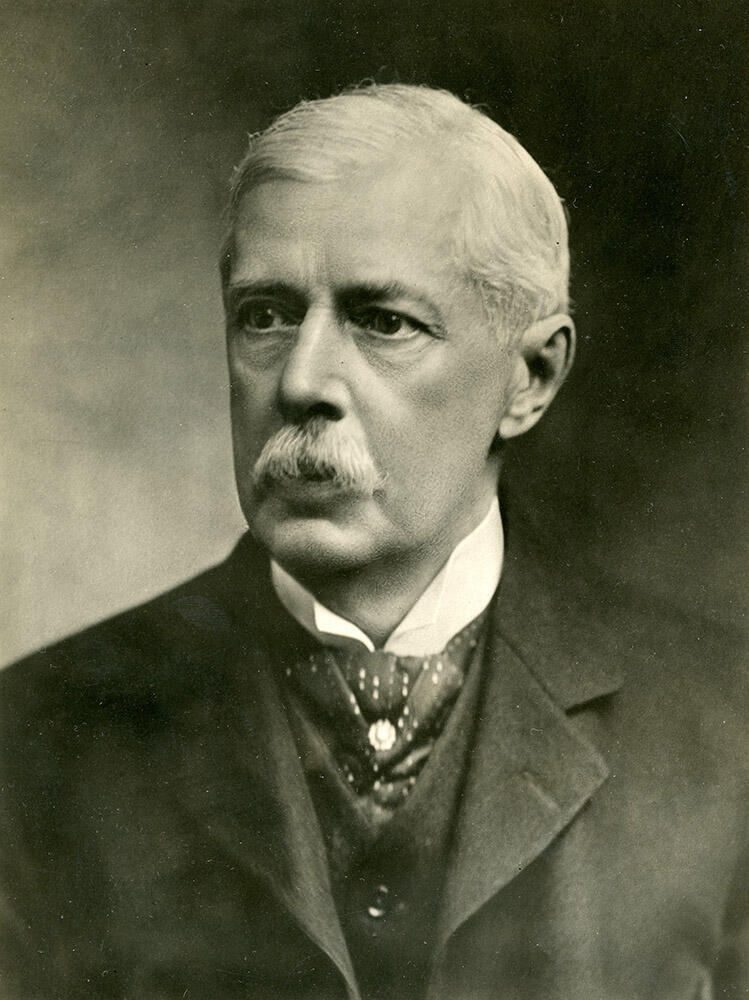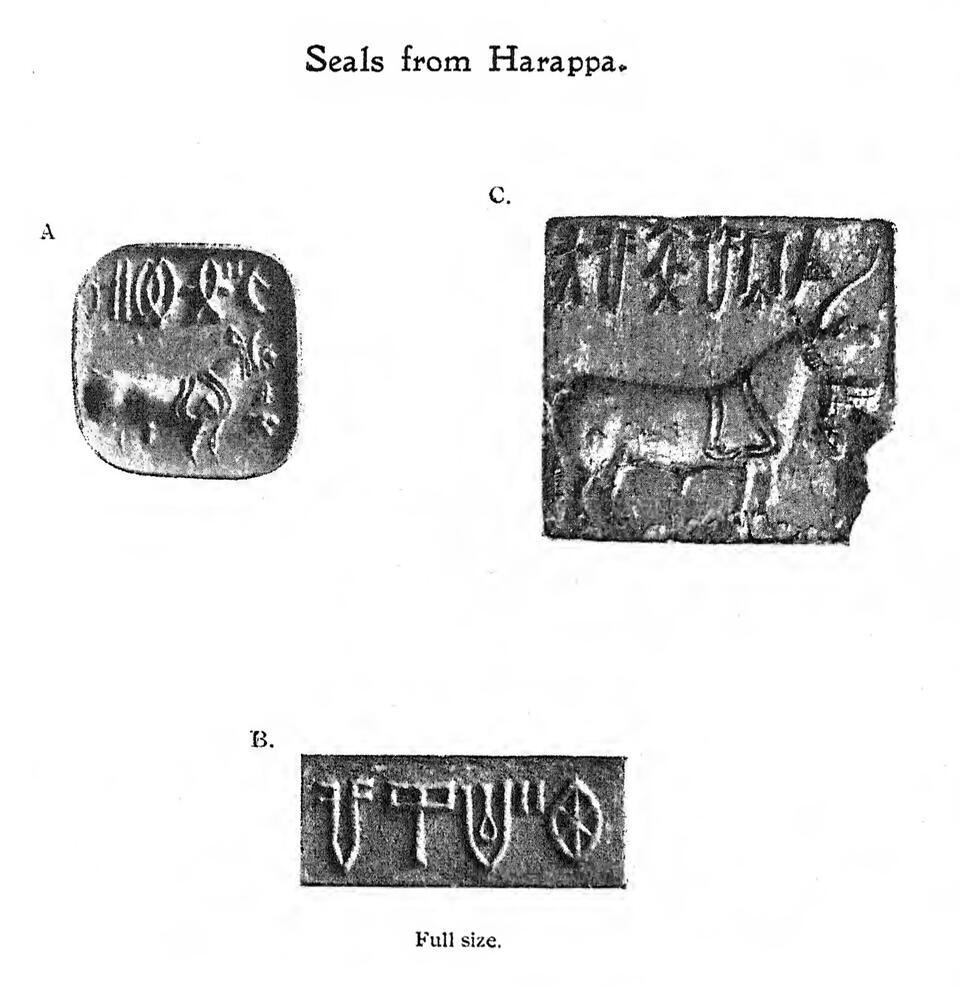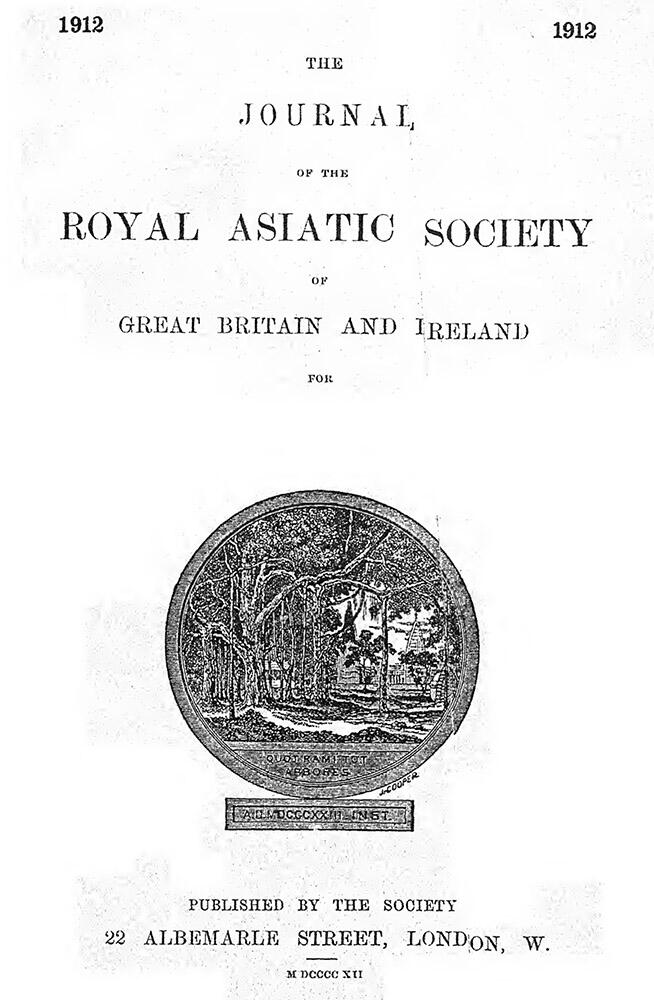John Faithfull Fleet (1847-1917) was an I.C.S. Officer who, like M. Longworth Dames, also made some major contributions to the study of Indian history, authoring works on South Indian history and, like Dames, becoming an important figure in the Royal Asiatic Society [RAS] after retirement in London. He too noticed that there was something unusual and common among these three seals from Harappa, which he published together in a single photograph in the Society's journal in 1912. Unlike Dames, he presented the letter seal (B, above) right side up, and the seals were shown as impressions (the positive image in clay). Nonetheless, it was Dames who again was in action by securing the third seal (C above) from O'Connor and one might surmise making his colleague at the RAS aware of the find.
Fleet does not mention that, in these images, we have for the first time, the same sign represented on B and C – in fact, the so-called most frequent "terminal" sign on the extreme left of Seal B is used twice in Seal C. According to Nayanjot Lahiri, writing about Sir John Marshall, then Director-General of Archaeological Survey of India, this set of seals together was consequential: "Marshall had actually begun the procedure for excavating it in 1907, after having reexamined the Harappa seals in the British Museum in 1906. After returning to India, he set in motion the administrative process necessary for beginning excavations there."1
The original article is below:
SEALS FROM HARAPPA
"Harappa is a village, having a station on the North- Western Railway, in the Montgomery District, Panjab: it is situated in lat [latitude], 80° 38', long, 72° 52V on the south bank of the Ravi, some fifteen miles towards the west- by-south from Montgomery. The place is now of no importance : but extensive ruins and mounds, one of which rises to the height of sixty feet, indicate that the case was otherwise in ancient times and it has yielded thousands of coins of the 'Indo-Scythians' and their successors.2 Amongst other objects of interest from this place, there are the three seals, full-size facsimiles of which are given in the accompanying Plate. The original seals are now in the British Museum, in the Department of British and Mediaeval Antiquities incharge of Mr. Read. In all three cases, the substance of these seals seems to be a claystone, hardened by heat or some other means. In the originals, the devices and characters are sunk : the illustrations represent impressions from the originals, with the devices and characters reversed, as compared with the way in which they lie in the originals, and standing out in relief. The animal on [Seal A, above] A has been held to be a bull, but not an Indian bull, because it has no hump : another opinion, however, is that it may be a male deer of some kind. The animal on C has a tail of such a nature as to suggest that this creature cannot be a deer. On A the hind legs were not fully formed and it is possible that a similar tail has been omitted there.
A.—This seal was presented by Major (General) Clark. It was found in or before 1872-73, in circumstances which are not known. It has been figured by Cunningham in his Reports, vol. 5 (1875), plate 33, fig. 1, and in his Inscriptions of Asoka, Corp. Inscr. Indic., vol. 1 (1877), plate 38 : and another illustration of it, to accompany a note by Mr. Dames, has been given in Ind. Ant., vol. 15 (1886 ), p. 1, fig. 1. It is about 1/4'' thick : and on the back, of it there is an arched protuberance, of about the same height, at right angles to the direction of the inscription, through which there is a small hole, in the direction of the inscription, evidently for inserting a string with a view to carrying it. It is illustrated now from a plaster of Paris impression for which I am indebted to Mr. Read. The first and last letters of the inscription were not formed as fully and deeply as the others : also, owing to the shadow thrown by the rim of the impression, part of the last letter is indistinct : the full form of this letter is
B.—This seal has been presented by Mr. J. Harvey of Ballycastle, co. Antrim, Ireland, formerly of the Indian Educational Service. In December, 1885, when he was inspecting the school at Harappa, a local agriculturist came in, bringing various things, one of which was this seal and it was obtained by purchase from him : but the circumstances in which it was found are not known. This seal was first brought to notice by Mr. Dames, in his note published in the Ind. Ant., vol. 15 (1886), p. 1, where it was unfortunately figured upside-down and without being reversed. I illustrate it from an impression which Mr. Read kindly caused to be made for me. At the ends the original is about 1/4' thick. From each end the back slopes up to a height of about 7/16" at the middle: and it is there perforated by a small hole, from front to back, for inserting a string. The edges pf the seal are not quite as sharp in the original as they are in the illustration.
C.—This seal, which is now brought to notice for the first time, has been presented by Mr. Dames. It was dug up by Mr. T. A. O’Connor, District Superintendent of Police, apparently in or shortly before August, 1886; and Mr. Dames obtained it from him. It is not quite thick. As in the case of A, on the back of it there is an arched protuberance, about high, at right angles to the direction of the inscription, perforated by a small hole, in the direction of the inscription, for inserting a string. It has been damaged at the lower corner on the right. The illustration has been made by photographing the seal itself; with the result that the devices and letters do not show their relief in the manner in which this detail can be seen in figures A and B.
The inscriptions on these three seals have remained, so far, undeciphered. Cunningham, indeed, in his treatment of A, though holding originally that the characters are ’certainly not Indian letters’’,3 proposed in his second notice to treat them as ''archaic Indian letters of as early an age as Buddha himself”, and to interpret them as giving the L-a-chh-n-i-ya.4 And on such an assumption it would not be difficult to find on C the word Ka-lo-mo-lo-gu-ta. But it is hardly possible to take the inscriptions really in this way. The present facsimiles are published in the hope that recent discoveries in various directions may give a clue to the true nature of the characters and the meaning of them."
- J. F. Fleet, Journal of the Royal Asiatic Society, 1912, pp. 699-701.
J. F. FLEET.
Images:
1. John Fleet, Courtesy Royal Asiatic Society, London.
2. Seals from Harappa
3. Front page of The Journal of the Royal Asiatic Society, 1912.
1. Nayanjot Lahiri (2017) Are archaeological discoveries like scientific discoveries? The curious case of the Indus civilization, World Archaeology, 49:2, 177, DOI: 10.1080/00438243.2016.12643.↩
2. See Cunningham, Reports, vol. 5 (1875), p. 105 ff.↩
3. Reports, vol. 5, p. 108.↩
4. Inscrs. of Asoka, p. 61.↩






